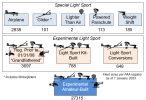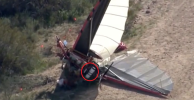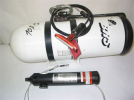The Sonex did fit the regulations in place at the time and my thinking was that because of the 16 hours ELSA repairman's course that registering it as such would make it more valuable when it was time to sell it.
I have heard that a couple of RVs were listed that way and have read some info on how it was done. If it's legal it has to be nearly crushing the regs and the limit of 1320lbs gross would make it a single person plane ...
I see eight RVs (including the two RV-10s) listed as Light Sport, not counting RV-12s, of course. One, an RV-8, is even listed as a Special Light Sport Airplane (e.g, supposedly sold as a ready-to-fly aircraft). Again, I suspect this is just a paperwork glitch, and that most of these planes have Airworthiness Certificates in the aircraft that show Experimental Amateur-Built.
Of those eight RVs, five initial airworthiness dates of 2008 or earlier, which meant they COULD have been submitted prior to the expiration date of the "Grandfather" clause. Two are RV-9s, which probably were best suited for it.
Friend of mine back then had an Emeraude (already licensed as EAB) and developed diabetes. He took the wheel pants and spinner off his airplane, lightened it up a bit, and declared that the airplane qualified as Light Sport under the definition of Part 1 and flew happily during until his passing several years ago (natural causes). No doubt the estate sold the airplane complete with the spinner, wheel pants, and all the other stuff removed. No doubt someone with at least a BasicMed certificate is flying it now.
Next two editions of Kitplanes magazine will have articles based on my statistical analysis of Light Sport accidents. What surprised me was the fact that the Experimental Light Sports had a fairly low accident rate...better than EABs, in fact.

But...there are a lot of factors here. First, of course, many of the ELSAs are very light aircraft that the owner can easily pick up and transport home after an accident...and thus never make it to the NTSB records.
Second, recall that the vast majority of Experimental Light Sport Aircraft got their certificates via the Grandfather aspect...

Many of the planes in the "Grandfathered" category had already been flying for years at the time they were converted to ELSAs. Their first flights, and any test period, was long behind them. About 50% of EAB accidents occur on the first flight or within the first 40 hours, and many of these new ELSAs were past that.
Ron Wanttaja

 www.fox10phoenix.com
www.fox10phoenix.com








